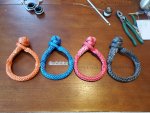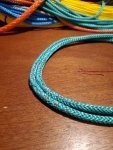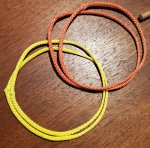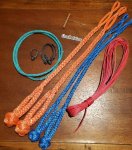Alloy
Well-known member
Hello Alloy:
Thanks for the informative reply. The failure of soft shackles via creeping of bury splice without lock stitching you describe seems odd to me. In soft shackles that I’ve made the integrity of the structure is independent of the bury. For the soft shackle eye to fail (other than breaking the line) the knot (whichever type is used) would have to untie. If one uses a button knot then the ends of the line are buried back into the shackle to increase the diameter of the shackle where the eye cinches down when loaded. That increased diameter increased the loaded strength of the shackle by increasing the bend radius of the line in the eye so it won’t break until the loads get extreme. But if the bury of the ends of line creeps so the ends come out of the line, the knot remains and the eye would still function fine, but with less ultimate strength (although still stronger than a single length of the line used). With some other knots then ends “after“ the knot are trimmed and there is no end bury in the shackle.
I’m assuming that the structure of the shackles that failed on you must be one I’m not familiar with - definitely possible as I’m no expert. I’d like to learn that structure If possible. Any chance of a link to the vendor or image of the shackles? I don’t doubt at all that the failure happened, I’m just curious about the structure that allowed the failure.
Howard
Working on getting pictures.

![20220309_114808[1].jpg 20220309_114808[1].jpg](https://forum.expeditionportal.com/data/attachments/614/614117-458bc021190a94c8a46637d60b592831.jpg?hash=RYvAIRkKlM)
![20220309_114844[1].jpg 20220309_114844[1].jpg](https://forum.expeditionportal.com/data/attachments/614/614119-26819ad7dc73aa2bce398c6048b28c5e.jpg?hash=JoGa19xzqi)
![20220309_123100[1].jpg 20220309_123100[1].jpg](https://forum.expeditionportal.com/data/attachments/614/614125-0c1a775cf2b42960479de4b090897b69.jpg?hash=DBp3XPK0KW)









